Easy Snow Skin Mooncake Recipe Without Rice Flour
The snow skin mooncake is made with a tender and fragrant mochi wrapper and a creamy custard filling. This recipe does not require special ingredients that are hard to find and you can get everything online if you don't live close to an Asian market. It's the perfect recipe to celebrate Mid-Autumn Festival.
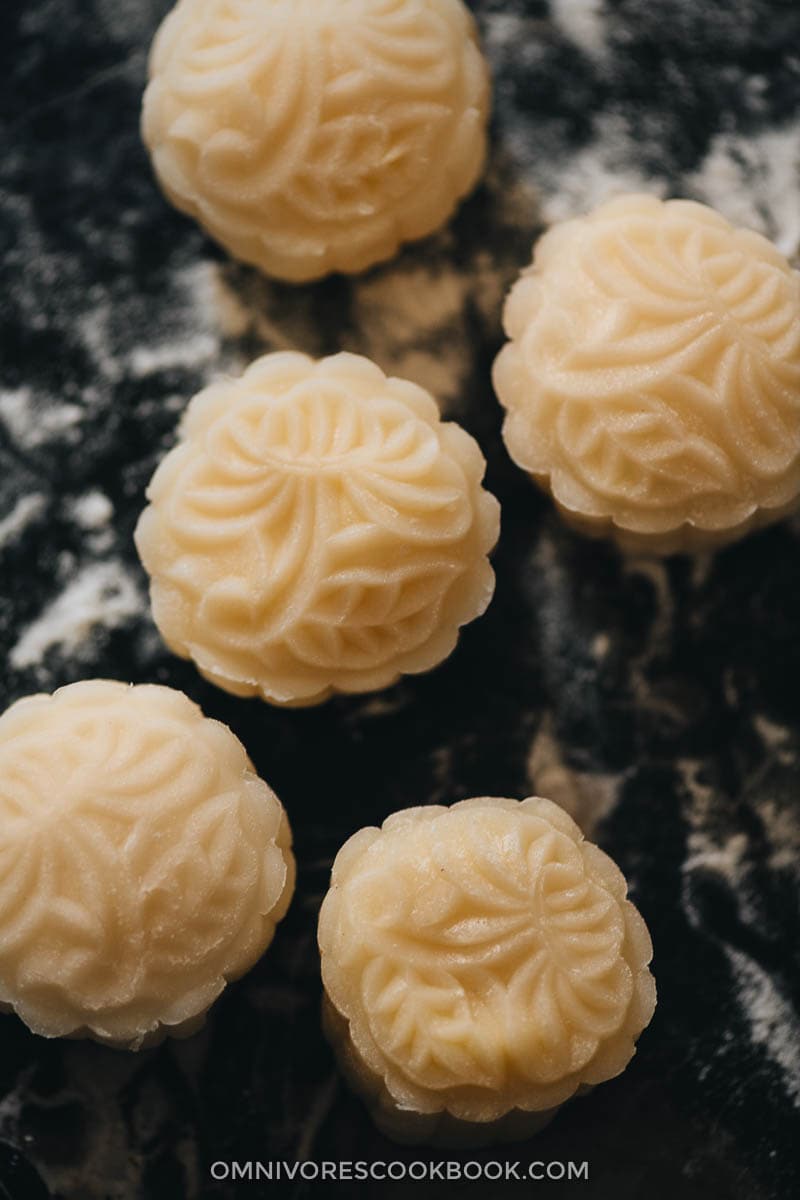
Mid-Autumn Festival is just around the corner and it's that time of the year that families start to buy or make their favorite mooncakes. Since I posted the traditional mooncake recipe, it has been four years! Last time, when I was trying to figure out the mooncake recipe, it took me a month and countless batches to perfect the recipe. I got quite traumatized and was unable to work on another mooncake recipe until now.
This time I decided to try out the snow skin mooncake. It a new type of mooncake that's gradually gaining popularity in recent years.
What is a snow skin mooncake?
"Snow Skin" is translated from the Chinese "Bing Pi" (literally meaning "Ice Skin"). The word snow is used because of the color and texture of the mooncake wrapper. Different from the traditional baked sugary pastry, the snow skin mooncake is made with sticky rice flour dough and usually served chilled. Sometimes people also call it a mochi mooncake because the texture is quite like Japanese mochi.
Just like regular mooncakes, snow skin mooncakes can be filled with red bean paste, black sesame paste, lotus root paste, and durian paste (super popular in Southeast Asia).
In this recipe I will be using a custard filling. Buttery, milky and creamy, it's one of my favorite fillings for dim sum and Chinese pastries.
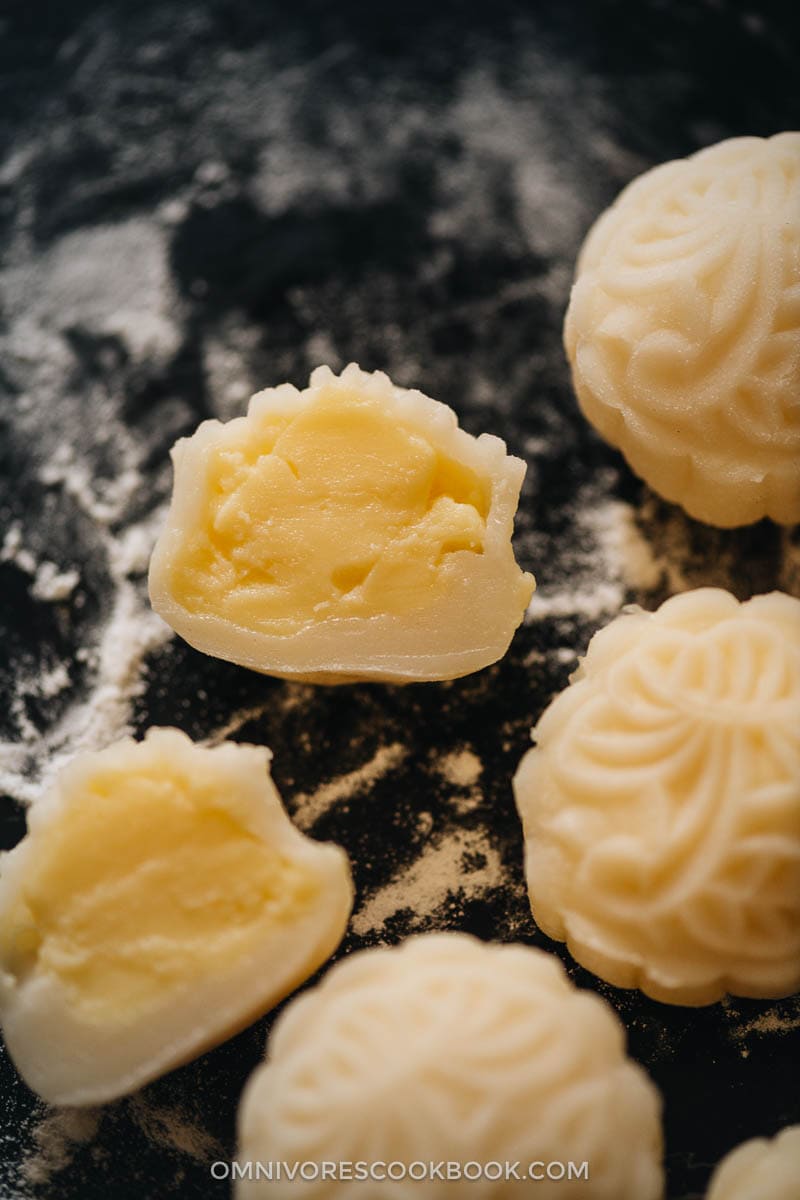
Two different approaches to making snow skin mooncakes
There are two mainstream methods to making snow skin mooncakes. I've tried both and ended up selecting the second approach. And here is why:
1. Snow skin mooncake made with Gao Fen
Gao Fen (糕粉) is also called cooked glutinous rice flour, or fried glutinous rice flour, is a type of processed glutinous rice flour that is used in making mooncakes and Cantonese dim sum. Because the flour itself is cooked, it can be mixed and eaten raw. Most snow skin mooncake recipes use this method, because the recipe is very easy to follow, requires less ingredients, and the end result tastes better.
However, this ingredient is very special and can be hard to find. So far I've only seen it in Asian grocery stores and cannot locate any online vendors that sell the product.
There are many online recipes that teach you how to make cooked glutinous rice flour at home. I've tried it many times, using different methods (steaming or pan-frying glutinous rice flour), and none of them came out like the product you get in the store.
The store-bought Gao Fen can be eaten raw. It melts in your mouth and it tastes very fragrant. The homemade one on the other hand, no matter how long I cooked it, was still very powdery, did not taste fragrant at all, and left an unpleasant raw taste in my mouth.
We tried many batches of mooncakes using homemade Gao Fen and failed. That's why we decided to turn to the other method.
2. Snow skin mooncakes made with mochi dough
This approach uses a flour blend – glutinous rice flour, rice flour, and cornstarch. You mix them with liquid ingredients, then steam the mixture to make a cooked dough.
The biggest benefit of this approach is, it doesn't require Gao Fen. The only special ingredient is glutinous rice flour, but you can easily find it in many grocery stores and on Amazon.
On the other hand, the wrapper does require a bit more steps to make and the result is a bit less fragrant than the one made with Gao Fen.
If you live in an area that's far from an Asian market and you cannot find Gao Fen, I highly recommend trying out this recipe. It yields a dough that is relatively easy to work with, firm enough to mold into the mooncake pattern, yet soft enough to have a good mouthfeel. We also added some vanilla extract to add flavor to the dough. Once you assemble the mooncake, the wrapper goes very well with the creamy custard filling and has a nice texture.

How to make snow skin mooncake – workflow
1. Prepare the custard
This recipe uses a standard custard recipe as the base. It contains more flour than regular custard so it is easy to form the mooncakes.
It uses 7 ingredients that are shown in the picture below.
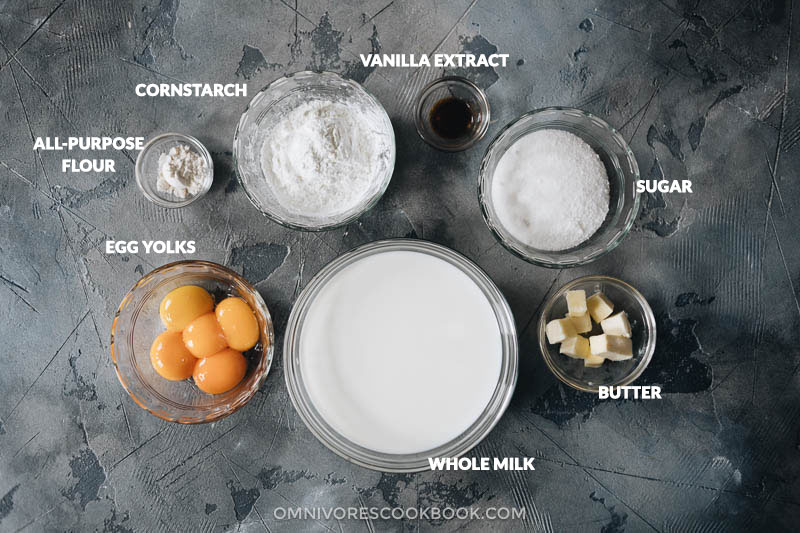
The workflow is:
(1) Mix the dry ingredients
(2) Heat up the milk and half of the sugar until warm
(3) Mix the egg yolks with the dry ingredients
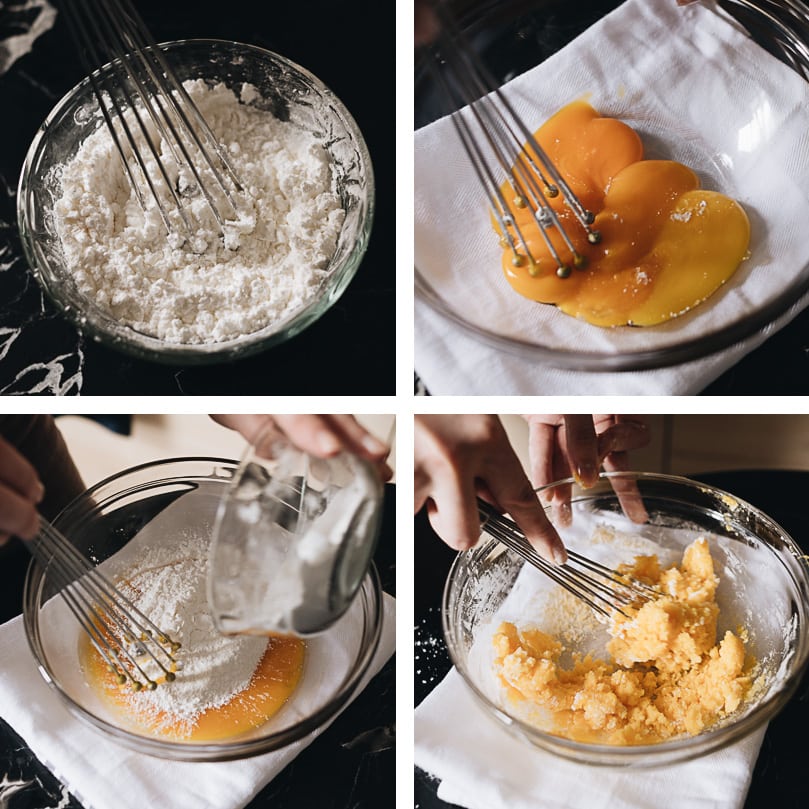
(4) Add the milk into the egg yolk and flour mixture
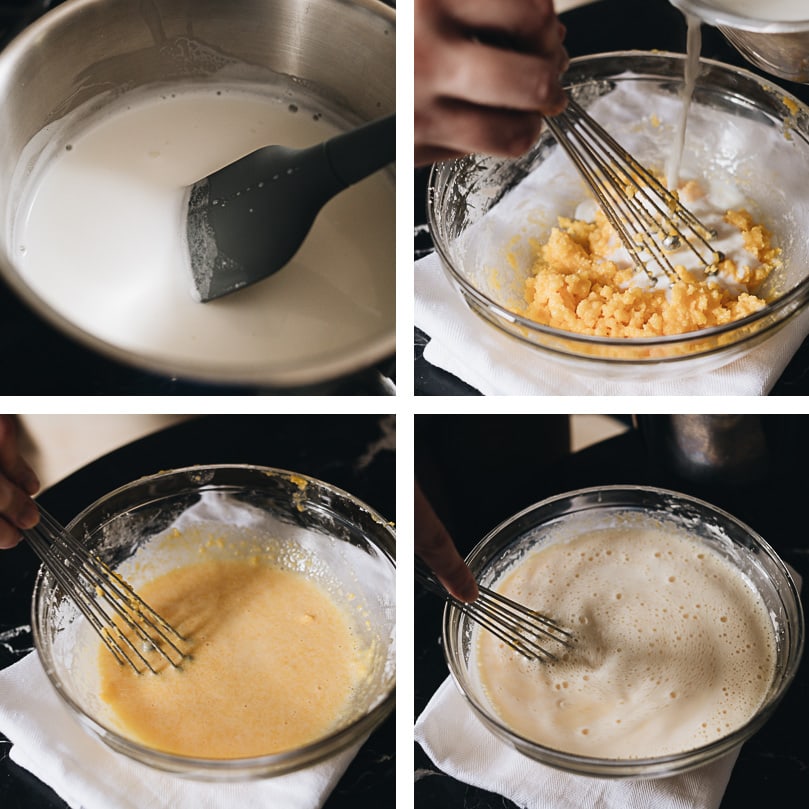
(5) Cook the mixture until it thickens
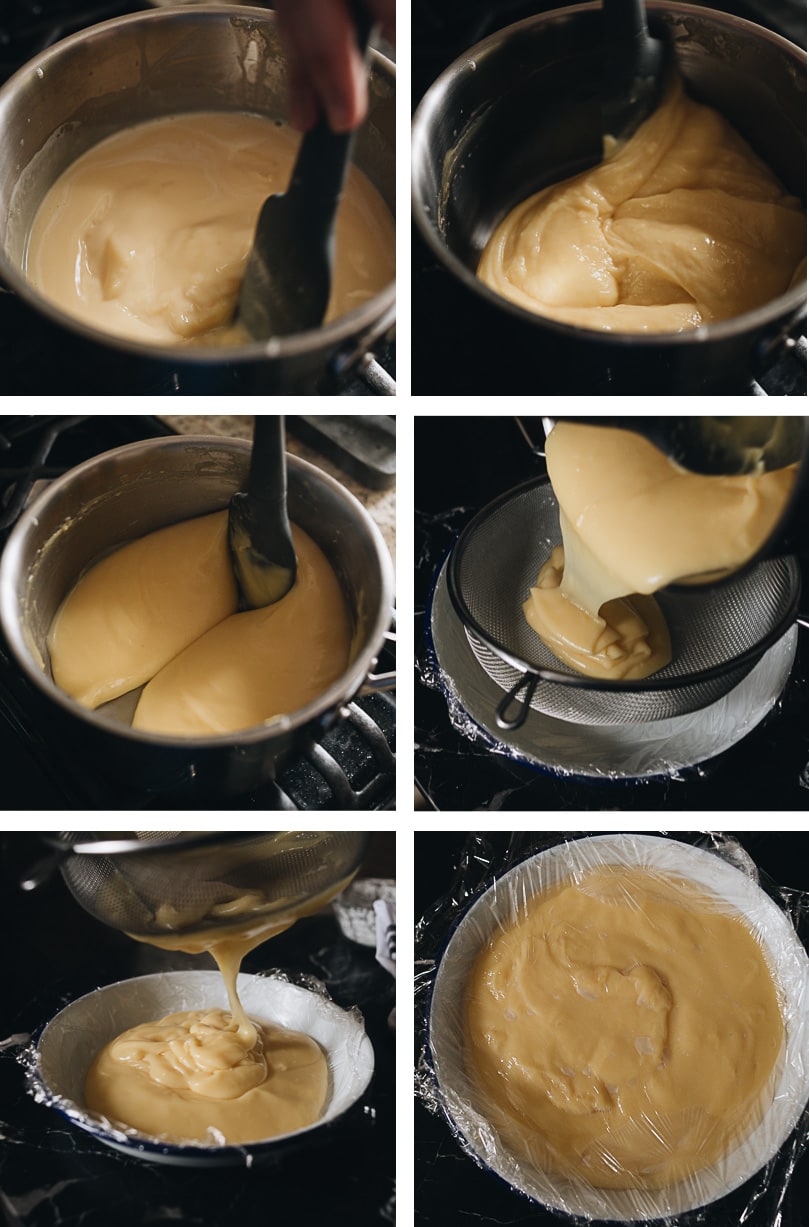
(6) Chill the custard in the fridge
Note:
- Make sure you don't overheat the milk, otherwise it will cook the eggs and make the filling into a lumpy soup. I usually use a thermometer to make sure the milk doesn't heat over 150 F (65 C). If you do not have a thermometer, you should heat up the milk over low heat until it's warmed up but not too hot if you put your finger into the milk.
- Do not mix the egg yolks with the dry ingredients before you heat up the milk. The sugar will cook the egg yolk and change its texture if added too early.
- Stir the custard constantly when you heat it up on the stove. The mixture will be very runny at the beginning and will take a few minutes to cook. But once it starts to thicken, it happens very fast, like flipping a switch.
- Chill the custard completely before forming the mooncake. The texture will harden and become possible to shape once cooled.
2. Prepare the dough
The dough uses 7 ingredients that are shown in the picture below.

The workflow is:
(1) Combine the dry ingredients
(2) Combine the wet ingredients
(3) Mix the dry and wet ingredients into a very runny batter
(4) Steam the batter until cooked through
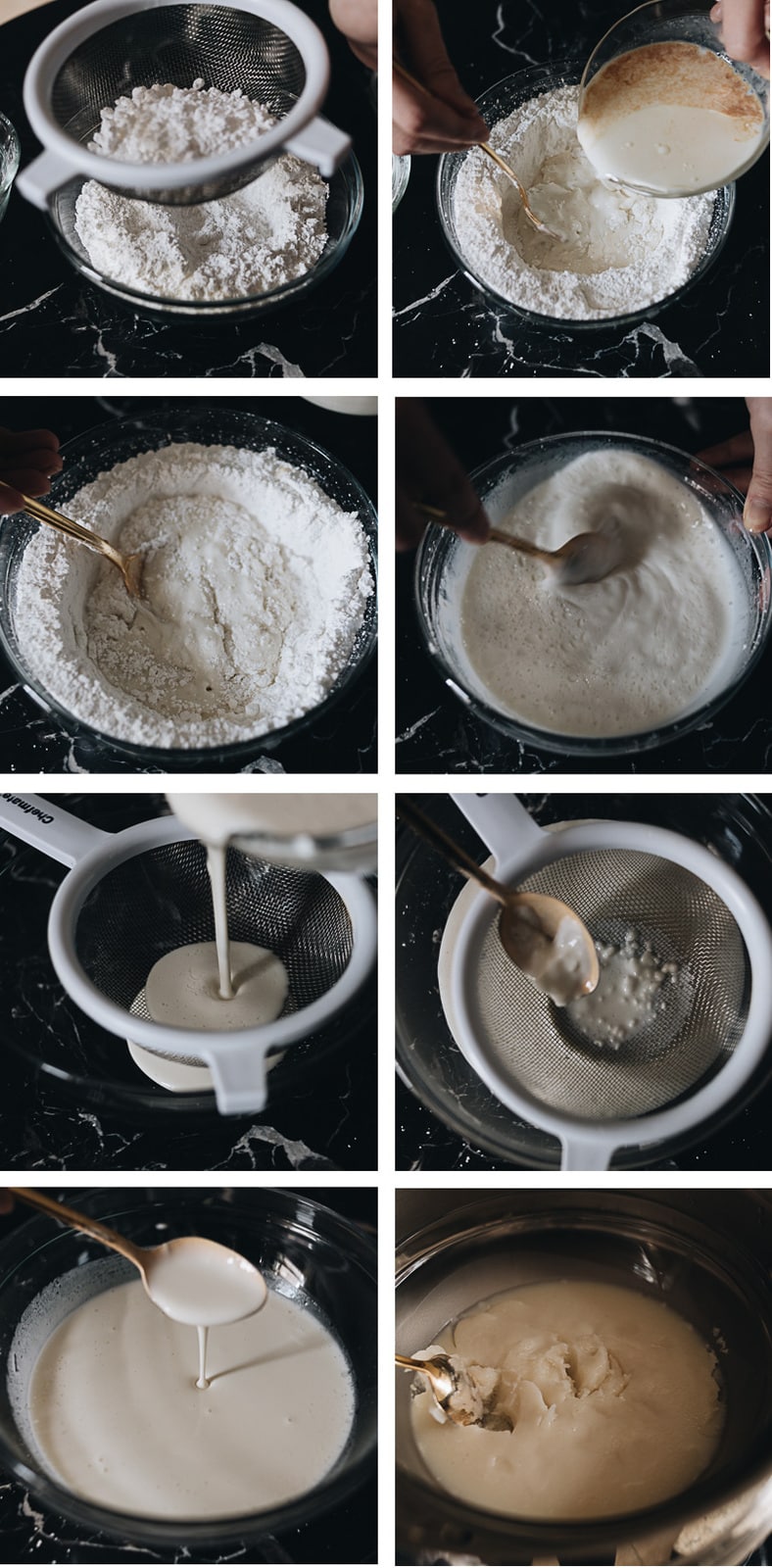
(5) Knead the cooked batter into a dough ball
(6) Chill the dough ball in the fridge
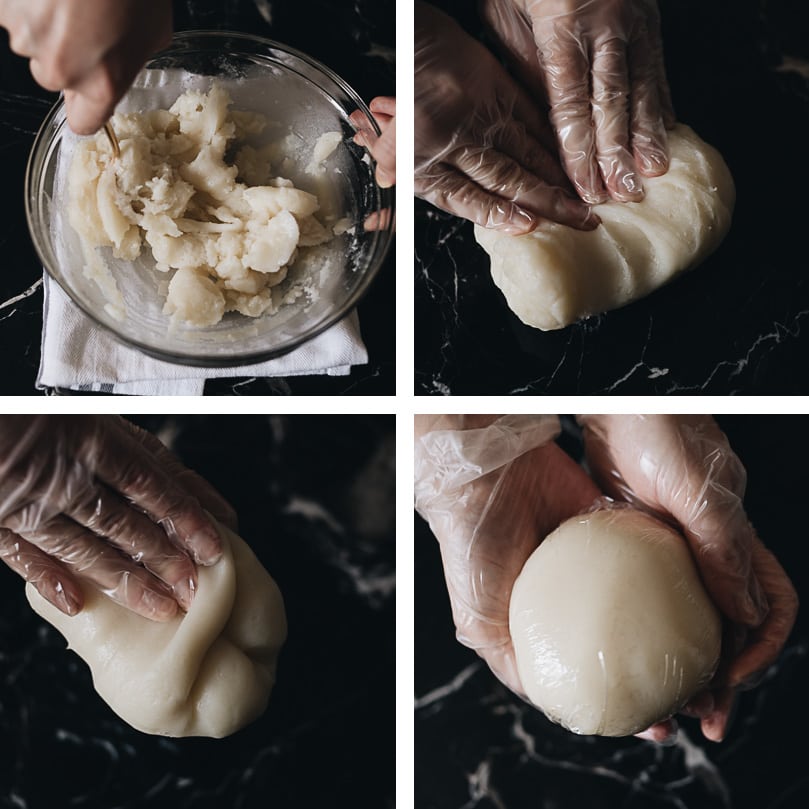
Note:
- You can add different extracts into the dough. Almond, rose, and pandan extracts all work in this recipe.
- You can add food coloring into the dough. Many recipes use a few drops of red or green food coloring to make pink and pale green mooncakes.
- Knead the dough once it's steamed. The texture of the dough will soften a lot and become more palatable once kneaded.
- Chill the dough in the fridge for at least 30 minutes, so it hardens up a bit for the molding.
- It's possible to make the dough ahead of time and chill it overnight. But we've found that the freshly made dough is easier to mold and tastes slightly better.
3. Make dough and filling balls
Once you've chilled the custard and the dough, shape them into balls.
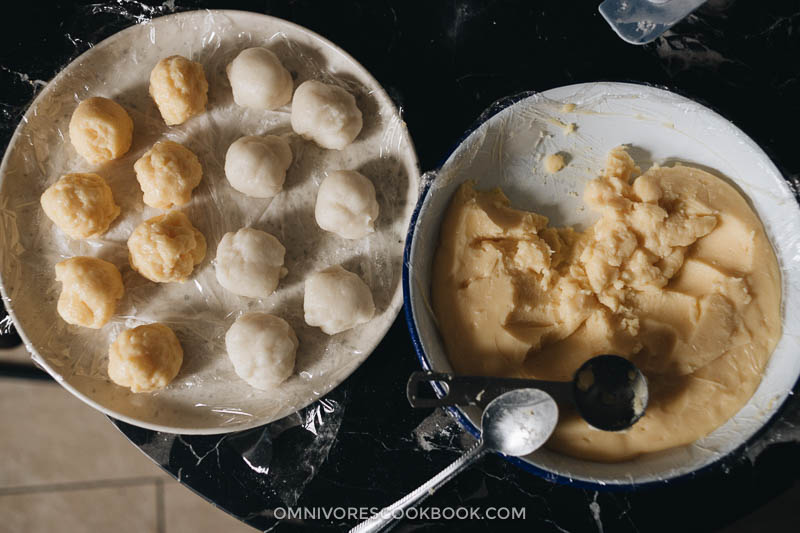
The easiest and most consistent way is to use a scale to measure out the portions. But if you don't have a scale, you can use a tablespoon to measure one round tablespoon of dough and one round tablespoon of filling.
In this recipe, I used 25 grams of filling and 25 grams of dough. For the dough, I measured out a bit more dough to make a larger wrapper, so it's easier to assemble the mooncakes. Once you wrap the mooncake, it will form more dough on top where you seal the filling. You can pinch off the extra dough so the mooncake skin will be even and thin throughout. It eventually makes a 45-gram mooncake (25 grams of filling + 20 grams of dough).
Once you've shaped the dough and filling into balls, cover them with plastic wrap again, and chill them in the fridge for another 30 minutes before molding. Otherwise, the ingredients will be too soft and won't keep their shape in the mold.
4. Assemble the mooncakes
To assemble the mooncakes, you need to:
(1) Roll a dough ball into a thin wrapper.
(2) Wrap the filling like you would wrap a dumpling (sort of).
(3) Pinch off the extra dough formed on top of the filling.
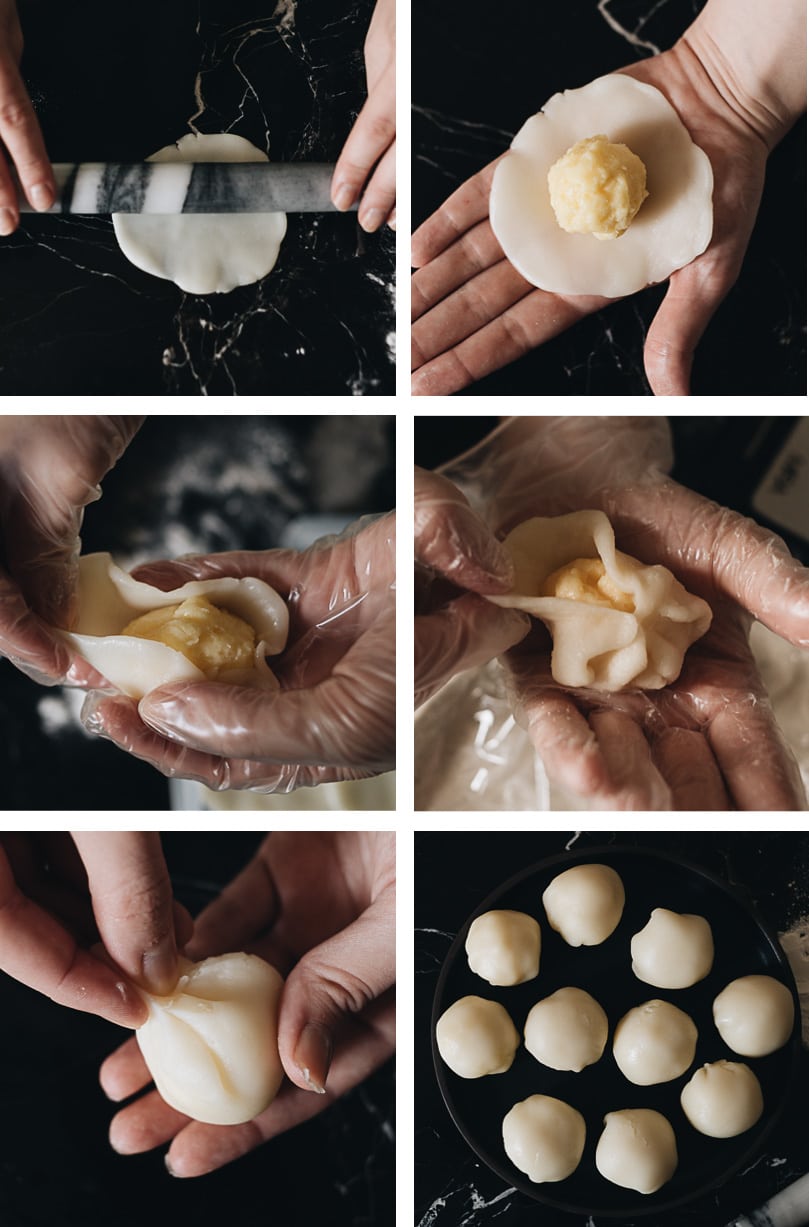
Note:
- You can use your hands to form the wrapper as well. Although I found that a rolling pin yields a thinner and more even wrapper.
- Do NOT dust your working surface with extra flour. The dough contains enough oil so it won't stick to your working surface easily. Adding extra flour will change the texture of the dough.
- You can wear a pair of disposable gloves when you work on the mooncakes. Personally I like to shape the dough using my hands.
5. Mold the mooncake
To speak the truth, the "mochi" you've made at this point is kinda ready to eat and tastes delicious. But of course, you'll need to mold them into beautiful patterns to call them mooncakes.
To make this happen, you need a mooncake mold. The traditional ones are made of carved wood. But I found that plastic molds are easier to source and quite easy to use. You can find them in Asian markets or on Amazon.
To mold the mooncake, you need to:
(1) Dust the assembled ball with a thin layer of cornstarch.
(2) Fit the ball into the mooncake mold and press for 30 seconds.
(3) Release the mooncake and pray that it comes out perfectly without falling apart.
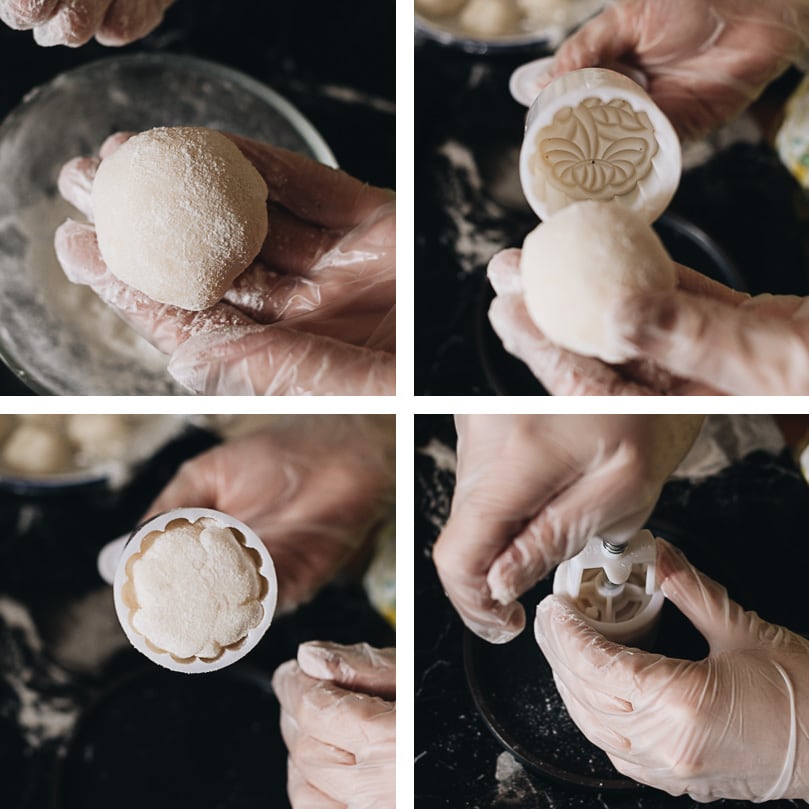
Note:
- Ideally, you should be using Gao Fen (cooked glutinous flour) to dust the mooncake. But since it's hard to find, most recipes ask you to cook the glutinous flour in a pan for the coating. I found that step unnecessary because cooking the flour doesn't eliminate its powdery raw taste. I used cornstarch to coat the mooncake, which is the approach usually used in mochi recipes.
- The pattern on the mooncake will fade a bit over time, which is unavoidable for any type of snow skin mooncake. Store-bought mooncakes use additives and are sometimes frozen to keep the mooncake in a perfect pattern. That's why homemade ones might look less perfect, but they actually have a much better taste than the store-bought ones.
Afterthoughts
Last time I made mooncakes, it took me a month to get the recipe right. This time, it took two people and around 30 hours of work to figure it out. I guess that's an improvement! Why two people? Because Omnivore's Cookbook just brought one more team member on board recently! This great news deserves a bit more space to talk about, so I'll keep it short here.
Hope you enjoy the recipe! I didn't have time to make a video this time, but I've included as many step-by-step photos as possible. If you'd like to watch a video, leave a comment to let me know!
Happy Mid-Autumn Day!
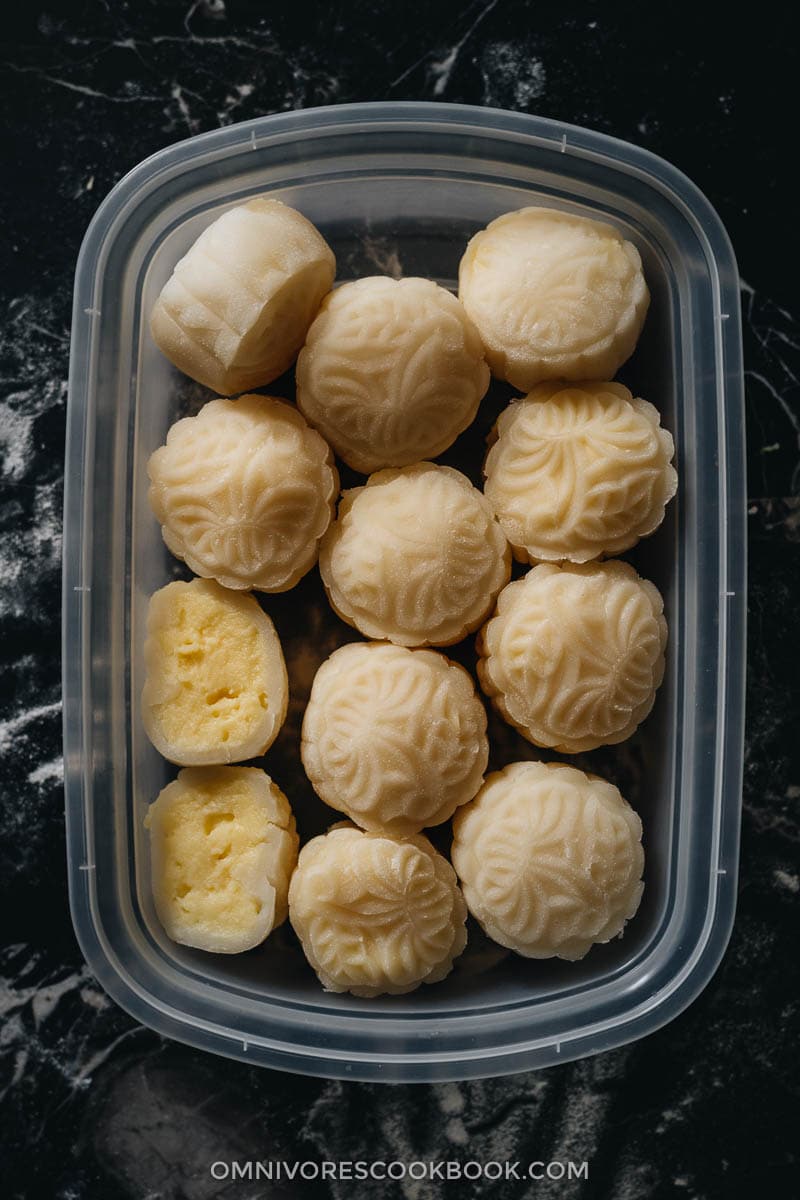
More recipes for Mid-Autumn Festival
- Traditional Mooncake with Black Sesame Filling
- Mid-Autumn Festival Menu
- How to Make Red Bean Paste
- How to Make Shumai (烧麦, Steamed Dumplings)
- How to Make Chinese Dumplings from Scratch
If you give this recipe a try, let us know! Leave a comment, rate it (once you've tried it), and take a picture and tag it @omnivorescookbook on Instagram! I'd love to see what you come up with.
Receive our 5-Day Chinese Cooking Crash Course & Recipe Updates! Subscribe
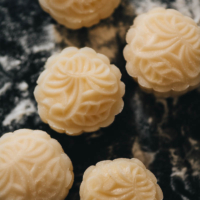
Snow Skin Mooncake with Custard Filling (冰皮月饼)
The snow skin mooncake is made with a tender and fragrant mochi wrapper and a creamy custard filling. This recipe does not require special ingredients that are hard to find and you can get everything online if you don't live close to an Asian market. It's the perfect recipe to celebrate Mid-Autumn Festival.
The recipe contains more flour than regular custard so it's easy to form the mooncakes.
Course: Dessert
Cuisine: Chinese
Keyword: festival food, mid-autumn festival
Prep Time: 2 hours
Cook Time: 30 minutes
Total chilling time: 3 hours
Total Time: 5 hours 30 minutes
Servings: 25 mooncakes (45 grams each)
Custard
- 40 grams (6 tablespoons) cornstarch
- 5 grams (2 teaspoons) all-purpose flour
- 112 grams (1/2 cup) granulated sugar
- 5 large egg yolks
- 480 grams ((2 cupc) whole milk
- 30 grams (2 tablespoons) butter
- 1/2 teaspoon vanilla extract
Wrapper
- 120 grams (1 cup) glutinous rice flour
- 120 grams (1 cup) rice flour
- 60 grams (1/2 cup) cornstarch , and extra for coating the mooncakes
- 100 grams (3/4 cup) confectioners sugar
- 350 grams (1 and 1/2 cup) whole milk
- 55 grams (1/3 cup) vegetable oil
- 1/2 teaspoon vanilla extract
Make the custard
-
Mix the cornstarch, all-purpose flour, and half of the sugar together in a small bowl.
-
Place the egg yolks in a large bowl. Stir a few times to mix the yolks.
-
Add the milk and the remaining half of the sugar into a small saucepan. Heat over medium heat. Stir occasionally to dissolve the sugar completely. Cook until it reaches about 120 F/ 49 C (no more than 150 F / 65 C). You might see a few bubbles here and there. If the milk starts foaming, it's too hot.
-
While the milk starts to get warm, add the dry ingredients (from step 1) into the bowl with the egg yolks. Whisk until it forms an even paste. Do not add the dry ingredients too early, because the sugar will change the texture of the eggs.
-
Add the warm milk into the egg yolk mixture, about 1/4 cup at a time. Whisk constantly until the milk is fully incorporated into the paste. Continue to add more milk a 1/4 cup at a time and keep stirring, until it forms a thin, smooth mixture and all the milk is added.
-
Return the mixture back into the pot (the one you used to heat the milk). Heat over medium heat and stir constantly, until the mixture thickens, 5 minutes or so. Keep cooking and stirring, until you can draw a line on the bottom of the pot using a spatula. (Note, the custard will start to thicken suddenly, like a switch was flipped. So you should keep a close eye on it.)
-
Remove the pot from the stove immediately. Add the butter and vanilla extract. Stir to mix well.
-
Line a large deep plate with plastic wrap. Place a large mesh strainer on top.
-
Pour the custard into the lined plate over the strainer to smooth out the texture. Use a spatula to press the strainer if any lumps remain.
-
Cover the custard with plastic wrap. Press the wrap against the custard, so it won't form a skin once it's chilled.
-
Chill the custard in the fridge until it's cooled completely, 2 hours or so. Or in the freezer for 30 mins.
Prepare the mooncake dough
-
Prepare a large bowl that can fit into your steamer. Place a large strainer on top.
-
In another medium-sized bowl, add the glutinous rice flour, rice flour, and cornstarch. Mix well with a fork.
-
Line a large mesh strainer over the bowl and sift the confectioner's sugar through it. Use your fingers or a spoon to press the sugar through if any lumps exist.
-
Add the milk, oil, and vanilla extract into a small bowl. Stir to mix well.
-
Use your fork to form a hole in the middle of the flour. Add 2 to 3 tablespoons of the milk mixture at a time. Stir until the liquid is incorporated into the flour completely. Repeat the process until it forms a very runny batter.
-
Pour the mixture into the large bowl (you prepared in step 1) over the strainer. Press the lumps using a spoon. Once strained, the mixture will thicken a little bit.
-
Prepare a steamer by pouring 1 inch (2.5 cof water into the steamer pot. Cover and heat over medium-high heat until boiling. Place the bowl with the batter into the steamer rack. Place the rack over the boiling pot. Cover and steam until the batter is cooked completely, 15 to 20 minutes. After 15 minutes, examine the dough by inserting a spoon into the middle. The spoon should come out clean, and the dough should feel very stiff.
-
Once done, remove the lid, and transfer the steaming rack with the bowl onto your kitchen counter to cool off for a few minutes.
-
Fold a kitchen towel a few times and place it on your working surface. Remove the bowl with the dough wearing oven mitts, and transfer the bowl onto the towel.
-
Scrape the dough from the bowl and knead it using a spoon, until it forms a dough ball, 5 minutes or so.
-
Transfer the dough onto a clean surface. Note, do not add any flour onto the surface or dust your hands with it. Knead the dough using your hands until it's smooth, 5 minutes or so. The dough will soften once done.
-
Wrap the dough with plastic wrap and chill it in the fridge for 30 minutes.
Ingredient storage
-
You can keep the dough and the custard filling refrigerated for a couple of hours, up to overnight, until ready to assemble. The dough will become a bit stiff if you chill it overnight. If you want the freshest taste, you should assemble the mooncakes the same day you make the dough and filling.
Assemble the mooncakes
-
Form the custard into balls - Measure 25 grams of filling (about 1 round tablespooand use your hands to press and roll, until it forms a ball. You can wear rubber gloves to help with this process.
-
Transfer the filling balls into a container and cover it with the lid. Chill for another 30 minutes.
-
Form the dough into balls - Measure 25 grams of dough (about 1 round tablespooand use your hands to roll it into a ball. Place the dough balls into a container and cover. Chill in the fridge until the custard is ready to use.
-
Place the dough ball on a clean working surface. Use a rolling pin to roll it into an even, thin, round disc that is about 4" (9 to 10 cin diameter. Carefully remove it from the surface onto your palm.
-
Place a custard ball in the center of the wrapper. Use your other hand to gather the wrapper onto the top of the custard filling. The dough sheet will start to form pleats and create a thicker layer. Try to pinch the extra dough together using your fingers, and pinch off the dough. The process will keep the mooncake skin even and thin, to create a better mouthfeel. Once done, place the mooncake onto a plate, pleated-side-down. Loosely cover it with plastic wrap to prevent them from drying out. Repeat the process to wrap the rest of the mooncakes.
To mold the mooncakes
-
Install the pattern plate into the mooncake mold, with the pattern side facing downward. If you're using the round shape, you can twist the lever of the mold so the pattern plate will snap onto the lever. It's not required but it makes the process a bit easier.
-
Dust the mooncake with a very thin layer of cornstarch. (*Footnote 1)
-
Carefully place the wrapped mooncake balls into the mold, smooth surface against the pattern plate.
-
Place the mold onto a clean, flat surface. Gently press the lever until the dough is against your table surface. Hold it for at least 30 seconds. It will help the pattern to form. Once done, push the lever to release the mooncake. Repeat the process to mold all the mooncakes.
-
The mooncakes are ready to eat!
Storage
-
Transfer the mooncakes into an airtight container. Store them in the fridge for 3 to 4 days. To enjoy the mooncakes with a better texture, transfer them to your kitchen counter and wait for them to return to room temperature. You can eat the chilled mooncakes, but the skin will be a bit stiff.
-
Note, do not freeze the mooncakes. This will change the texture of the custard and make it very grainy.
- Most mooncake recipe calls Gao Fen (or cooked glutinous rice flour) for this step. If you have Gao Fen on hands, you can use it for the dusting. If not, simply uses cornstarch and the result will be good as well.
Serving: 1 mooncake (45 grams) , Calories: 137 kcal , Carbohydrates: 25.1 g , Protein: 2.4 g , Fat: 3 g , Saturated Fat: 1.6 g , Cholesterol: 48 mg , Sodium: 25 mg , Potassium: 56 mg , Fiber: 0.5 g , Sugar: 10.3 g , Calcium: 43 mg
This recipe is brought to you by Lilja Walter and Maggie Zhu. We worked closely together during the process. While Lilja took the lead on recipe development, including research, recipe creation and testing, and making the final product. Maggie participated in the whole process to make decisions on the overall direction and was in charge of the writing, photography, and final production of the blog post.
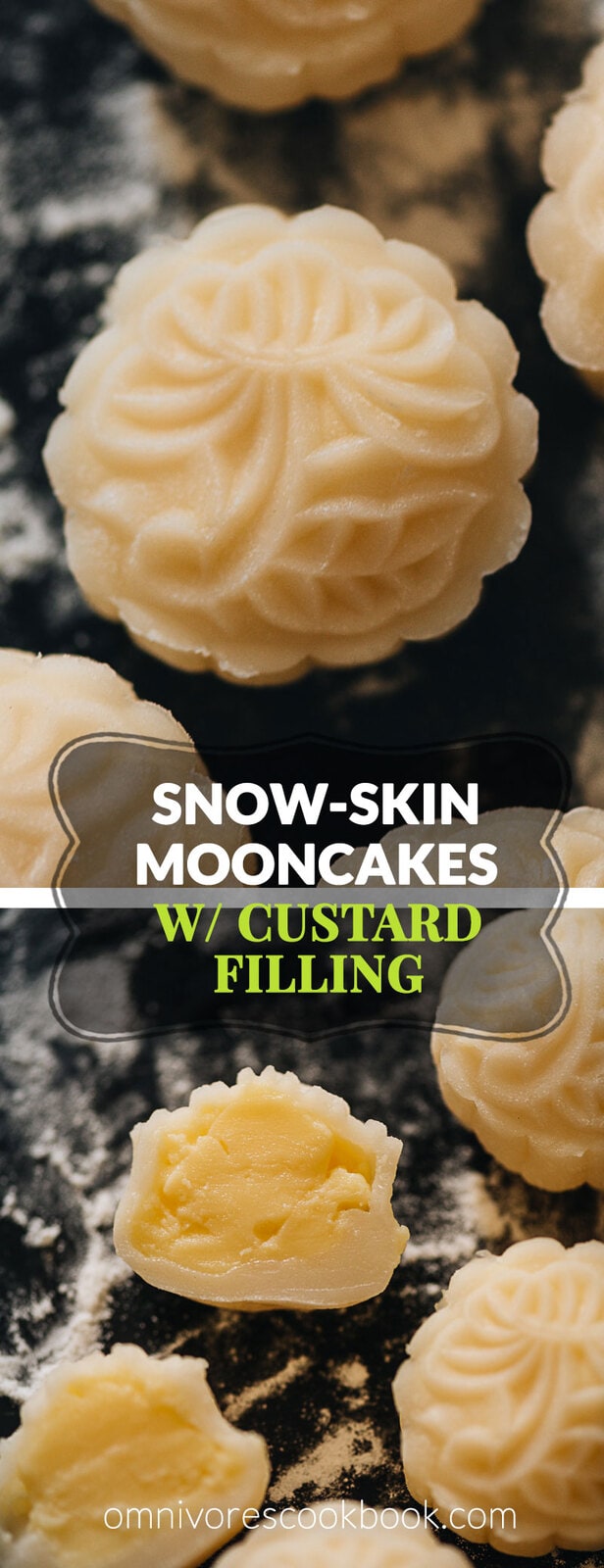
Source: https://omnivorescookbook.com/snow-skin-mooncake-custard/
0 Response to "Easy Snow Skin Mooncake Recipe Without Rice Flour"
Post a Comment